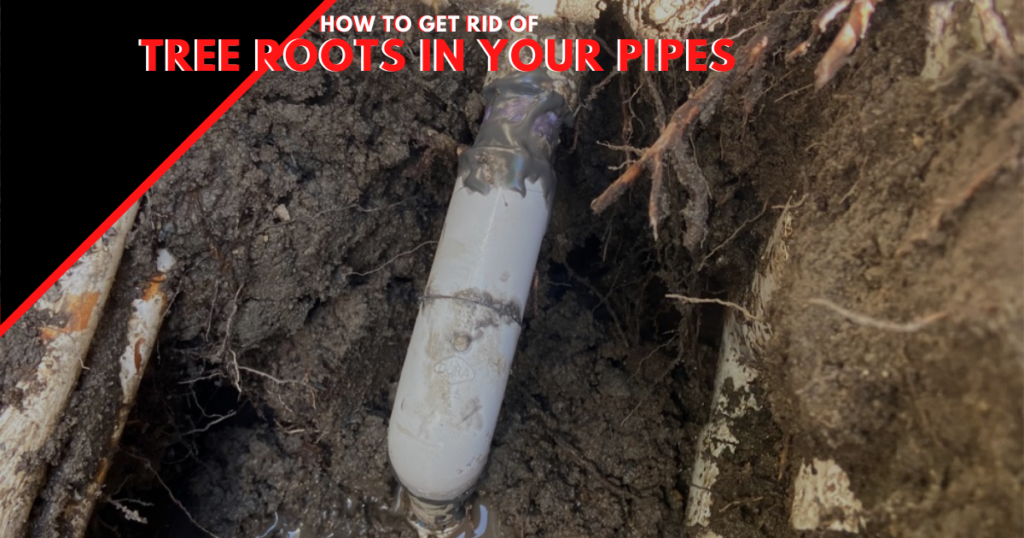
In several communities around the nation, tree roots continue to plague some of these areas with severe sewer line clogs. For years, sewer pipes could have tree roots growing in and around them and they can go undetected, but while we ignore them, they continue on their trek to worm their way into sewer systems in any way possible.
Tree roots are looking for water and nutrients needed to keep the tree alive. Because of the design of a sewer, tree roots are drawn to sewer pipelines. This causes slow drains as the roots penetrate the pipe wall and cause cracks and even a loose joint. Even a tiny crack can become a big problem if it’s undetected or left untreated.
While you can’t control where tree roots grow, there are some things you can do to help with removing tree roots near your underground pipes. And don’t think it’s just the big roots you need to worry about. The small tree roots can be just as damaging to your plumbing system. There are also a few things you can look out for that are signs of having a root invasion in your drain pipes.
Small cracks or even pipe joints represent easy access for the roots to get into the sewer lines. They grow unabated and get their nutrients from the water and waste as it leaves your sewer system. The tree roots grow quickly and before you know it, they’ve reached a point where the roots are so big that they block the sewer pipe completely. That kind of blockage causes every drain in your home or business to backup.
That includes everything: tubs, showers, and sinks too. If the damage becomes severe enough, it can flood and cause serious property damage. If you find yourself in this situation and aren’t sure what to do, call Orange County’s #1 plumber – Olson Superior Plumbing and learn how to get rid of tree roots in the sewer line.
How Do I Know If I Have Tree Roots in My Pipe?
As your home ages, it becomes easier for this kind of damage to occur because the roots have grown unrestricted for years, and formed an extensive network of root systems under your lawn. Routine maintenance of your sewer systems can help catch the problem early before they cause serious damage to your sewer lines.
The Environmental Protection Agency (EPA) has said that intrusion by roots is now the single most destructive event that happens to a wastewater collection system. Now that you know more about the potential damage clogged sewer line tree roots can cause, here are some tips to rid your system of roots before damage occurs.
If your drains are draining slowly, you may have tree roots in your sewer line. Contact a plumber who can do a sewer camera inspection to determine if and where you have tree roots causing problems in your existing pipe and utility lines.
Want to try to remove those tree roots in your sewer lines yourself? Here are some things you can try yourself before contacting a professional. Keep in mind that these root killers are a temporary fix to get rid of the roots. To prevent future roots in a sewer line, you need to use root killers for a permanent solution.
Copper Sulfate Crystals
Find copper sulfate crystals at almost any hardware or garden supply store. They’re popular for use in killing roots inside sewer lines. Pour one-half cup of the crystals into your toilet water and flush.
After flushing, the crystals come into direct contact with the root obstruction. The roots disintegrate, but only the roots. Many favor this technique, claiming it’s the most environmentally friendly way to rid the system and perform safe root management of clogged sewer line tree roots.
Another use of chemicals for root removal involves the use of aquatic herbicides like Dichlobenil or metam sodium. Before working with chemicals such as these, it’s a good idea to confirm with your local sewer district that the use of chemicals for root management is not prohibited.
Hydro Jetting
The preservation of the environment is on everyone’s mind these days. Hydro-Jetting is a high-pressure water pump that produces enough pressure and the hydro jets it produces forces water through your drain system to flush sewer line tree roots from there out into the drain basins, where they clean it out thoroughly.
Some hydro-jetting equipment comes equipped with water-propelled nozzle heads with spinning blades called root cutters and is also called a sewer machine. Professional grade water jetters carry a hefty price tag, but the price is worth it compared to less expensive and less effective units. While this method might be more expensive, it can keep your drains open longer which can wind up saving you money in the future.
Coil Rodders
Some of you have had the opportunity to see these in action. You may recognize the name drain cable machine. Professional drain and sewer companies often use this type of equipment to clear out entire sewer system lines 4 inches in diameter to as large as 12 inches in commercial buildings.
The rodder contains stiff, but flexible steel cables rotated through the sewer line. They have a razor-sharp C-shaped cutting blade that rotates with the cable and cuts away roots as it comes into contact with them. Aside from using chemicals, the electromechanical apparatus is the answer to how to get tree roots out of the sewer line.
Contact A Reputable Plumber
In most cases, home treatment may not kill the roots, so you could be facing another root problem in the future. It might not be a big deal now, but in the long run, just a couple of new trees and new roots could cause a big problem. Instead of grabbing something at your local hardware store, contact trusted drain technicians in your area.
Not sure where to find a trusted plumber in your area that can help with sewer line repair? Try asking friends and family for their recommendations. Check the company’s reviews with Yelp or Google My Business before reaching out to set up a service call to have them take a look at your sewer system.
You want to make sure the technicians are using technology like a mechanical auger and can do a camera inspection of your system to spot tiny cracks or tree root water lines or drain pipes. A trained professional may be able to help you remove the problematic roots without causing damage to or killing the tree or bushes they’re growing from.
If you have any questions, call our 24/7 Rapid Response Team at 949-328-6002 or email us at 247@OlsonSuperior.com – If you want more information online, please visit us @https://www.OlsonSuperior.com
For industry insights, announcements, and tips make sure to follow our blog at: olsonsuperior.com/blog

